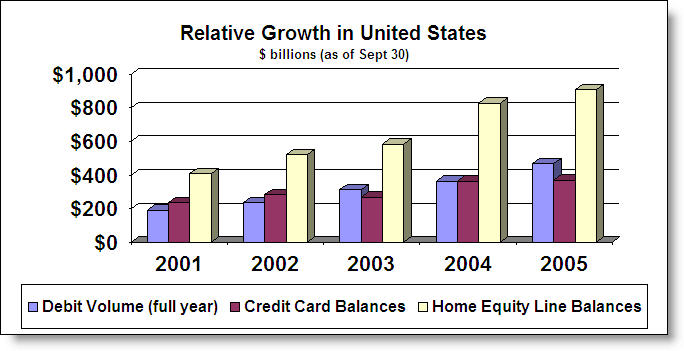The credit card giant offers online payment of outside
bills even if the merchant payee does NOT accept credit cards.

MBNA ($142 billion, 40 million cardholders) offers something we’d
been expecting for years, a bill payment program that draws payments from a
credit card. The company even posts the transactions as cash equivalents,
offering the same 15- to 45-day float afforded regular card purchases.
However, bill payments do not earn points in MBNA’s reward programs.
Furthermore, payees are limited to those that can be paid electronically by
CheckFree, although that’s now covers 70% of the processor’s volume.
Consumer Benefits
Pros
- Added float, as one message board poster said, “why worry
whether you get a few days float (from your bank), when MBNA provides a
whole month”
- Convenience of tracking more expenditures through the
card-management system.
- Ability to repay over time.
- Option of charging bills to an MBNA card or debiting from any
checking account.
- Free, so long as the cardholder initiates at least two payments
per month from their card account (see fee schedule opposite)
Cons
- No real drawbacks, except for the confusing price schedule.
Consumer advocates might argue that it encourages cardholders to take on
more debt, but they could already do that by paying bills with convenience
checks.
Financial Institution Business Case
We’ve long maintained that loan generation is the most important
institutional benefit of online bill payment because. Why? If given the
opportunity, users will likely charge several bills per year to an
integrated credit line .
While you will lose money on convenience users who repay the charges each
month, revolving balances should more than compensate. For example, in our
back-of-the-envelope calculations, we estimate a total net profit of $60 per
year per user of credit card bill-pay, or $600,000 annually across a
10,000-user customer base.

The Most Confusing Fee Schedule in the World:
MBNA’s Bill Pay Choice may be among the most flexible online, but
its fee schedule is utterly confusing. Perhaps the company should consider
charging a nominal flat fee that’s waived if charging 2 or more bills.
Of course, any new credit card program must be monitored closely for abuse,
both outright fraud, by setting up a phony electronic merchant, and less
sinister gaming of the system where a user becomes an electronic merchant on
CheckFree’s system and pays himself each month to earn the float. However, since
no reward points are awarded, there is far less incentive to play games.
Card issuers could limit their exposure by setting a maximum monthly amount
of bill payments, especially for new cardholders.
How it Works
MBNA cardholders must first register for online access at MBNA’s NetAccess
www.mbnanetaccess.com
After that, they register for Bill Pay Choice. Users can pay bills either by
charging to their MBNA card or debiting any U.S. checking account. MBNA does not
offer its own checking account; however, payments can be drawn from MBNA’s money
market account.
The service is free unless the user pays bills only from their checking
account, in which case the fee is $0.75 per transaction. Users may qualify for
unlimited free checking-account bill payments provided they charge at least two
bills to their card each month.
Table 13
Mini Business Case: Card-based bill payment
monthly benefit, assuming 6 payments totaling $1000
|
Factor |
Assumptions |
Result |
| Direct Costs |
|
|
| Cost of float |
30 days at 2% |
$1.67 |
| Cost of transactions |
6/mo to CheckFree |
$2.00 |
| Cost of service/mo |
internal |
$0.33 |
| Total cost/mo |
|
$4.00 |
| Direct Revenues |
|
|
| Increased outstanding balances |
$167 x 12 months
x 5% spread* |
$8.35 |
| Fees from DDA trans |
|
$0.15 |
| Total revenue/mo |
|
$8.50 |
| Net profit/mo |
|
$4.50 |
| Annualized |
|
$54 |
| Intangibles |
|
|
Extra interchange from increased charge
volume |
1% x $300/yr |
$3/yr |
| Increased retention |
2% increase x $150/yr |
$3/yr |
Total per user
per 10,000 users |
|
$60/yr
$600,000 |
Source: Online Banking Report estimates, +/- 33%, 2/04
Revenue assumptions: 1 out of every 10 bills will be revolved (10%); revolving
balances will be repaid in equal installments over 12 months (6 months average
life); interest rate spread = 5% (net of charge-offs)
 Those that went online were greeted with this almost-blank screen operating under a different URL www.applyforcreditnow.com and had no reassuring message or graphics to assure users they had not arrived at a phishing site.
Those that went online were greeted with this almost-blank screen operating under a different URL www.applyforcreditnow.com and had no reassuring message or graphics to assure users they had not arrived at a phishing site.  After entering the 6-digit code from the mailing, prospective cardholders are transported to this boring form, which surprisingly includes MORE fields than its paper-based counterpart (click on inset for closeup; click on continuation below to see the full 800 x 5200 screenshot). For example, it contains a section to be completed by students, who are unlikely to be receiving this particular Fidelity Investments WorldPoints Visa card with no preset spending limits.
After entering the 6-digit code from the mailing, prospective cardholders are transported to this boring form, which surprisingly includes MORE fields than its paper-based counterpart (click on inset for closeup; click on continuation below to see the full 800 x 5200 screenshot). For example, it contains a section to be completed by students, who are unlikely to be receiving this particular Fidelity Investments WorldPoints Visa card with no preset spending limits. 


